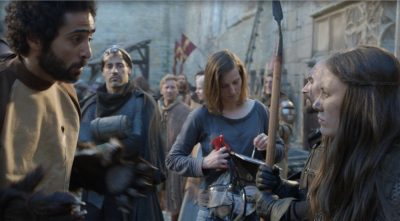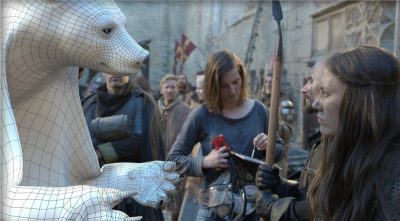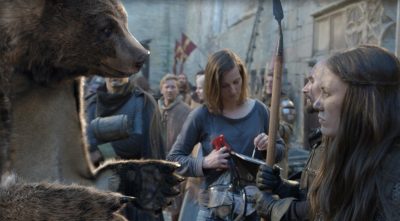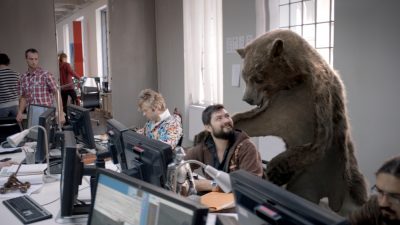We had such a big reaction to the piece we published earlier in the week about Canal+ ‘The Bear Rug’, that we decided to speak directly to the team at Mikros image in France responsible for the visual effects for this amazing spot that will surely go on to clean up at Cannes and the other award shows. We spoke to VFX supervisors Laurent Creusot and Guillaume Ho at their studio in Paris.
– Above: watch ‘The Bear Rug’.
fxg: Firstly, congratulations on the spot.
Laurent Creusot: Thank you. It was a pleasure to work on it from beginning to end. The script was so good. We worked a lot with Matthijs the director, and we were very happy.
fxg: And this was roughly the same team that worked on the wardrobe spot (an earlier Canal+ spot featuring a man and a closet)?
Creusot: Yes, I worked on the wardrobe spot, but there is no CGI on that spot, only Flame.
fxg: How did you go about doing the bear?
Creusot: At the beginning we were exploring a number of different options. We wanted to try with a huge puppet, and after we were going to just replace the face. At the end, everybody thought the best way would be to do a fully CG bear. We had an actor to have all the interactivity on set. It was great to have a good actor and it helps to find a good way to do the animation. But it was a huge amount of work to make him very big but very thin. To have a character, he needs to be sympathetic – it was a funny bear – but he needs to be real and take a lot of space in the image but at the same time be very thin.
On set
fxg: How many days were you shooting?
Creusot: It was three days. One day for the first sequence in the castle, and two days for the rest.
fxg: What did you shoot on set?
Creusot: We had the real actor in a bear skin on set – one take with the bear, some color reference and HDR. There was no empty plate – just the main plate.

fxg: So on set there was an actor standing in that you then digitally removed?
Creusot: Yes, exactly. You want to be really easy for the director, and not have too many technical things to do on set. We want to be very free with the camera. He shoots like a real guy – you don’t want to have a lot of trackers.
fxg: In some of the shots, the bear interacts closely with some things. In particular, there’s a point where he has the desktop and a director’s viewfinder up – what was CG and what was real?
Creusot: At the beginning we shot with a real viewfinder and we wanted to keep the viewfinder, but it wasn’t working when we wanted to change the animation a little bit. So we replaced it all.
Post
fxg: How long did you have in post-production?
Creusot: One month for the prep and two months for delivery.
fxg: The tracking was clearly important with no special trackers on set, what did you do the 3D tracking on?
Guillaume Ho: For the 3D track, we used Syntheyes.

fxg: What were you using for the 3D?
Creusot: We were using Maya and Arnold for the rendering. We pre-comp’d in Nuke and final compositing in Flame.
Ho: At the beginning we had Shave and a Haircut for the fur.
fxg: Do you always use Arnold for your renderer?
Creusot: Yes, we have been working with Arnold with more than 10 years. We started very early with them.
fxg: So the frames coming out of Arnold, were they multi-layered openEXRs, or were you doing it as a single beauty pass.
Creusot: We tried to have as few passes as possible.

fxg: It seemed that not only was the fur good, but was there any sub-surface scattering going on?
Ho: I don’t think so – we used a Marschner shader that simulates sub surface scatering for fur.
Editors Note: A Marschner Shader refers to a 2002 Siggraph paper “Light Scattering from Human Hair Fibers” by Stephen Marschner et al. The Marschner paper bases its model of human hair on empirical measurements of light scattering from a single hair fiber. The main result of the paper is that hair scattering exhibits three highlights: a primary highlight, which is a direct specular reflection from the surface of a hair strand; a secondary highlight (shifted away from the primary), the result of light penetrating into the hair (transmission), reflecting internally, then exiting at a different location; and a transmitted component, dealing with light transmitting directly through the hair (as in illumination from back lighting).
fxg: Was the offline edit you got the one that’s in the final spot?
Creusot: Because of the sync with the sound, because he’s talking, we didn’t have a lot of space to change the edit.
fxg: The mouth on the end shot seemed very important for the ad to work, how was the face done?
Creusot: When he’s on floor, for the animation, he had to have a small smile, but not too much, and lots of work on the lighting on the nose and eyes.
fxg: When you’re the compositing the bear into the shots, were you doing a lot of work in the Flame to make it sit in? Or was it mainly out of the Arnold renderer?
Creusot: The main compositing was in Nuke – just fine-tuning in Flame.
fxg: Were there other effects to be done such as the fighting scenes?
Creusot: We did do some explosion on the tower, and after that just adding in some blood in the fight scenes. We had a bluescreen for the orchestra shot, so we added all the footage that was of course only shot the day before in reality. We also changed the size of the TVs but these were just small details, oh and I had to make up the user interface of the visual effects computer so that it was not anyone’s actual program (when the ‘director” is reviewing the VFX).
fxg: What did you shoot it on?
Creusot: We used the ALEXA.
fxg: I ask as one thing I really liked was, when we see the behind the scenes footage, it looked like it was shot on cheaper cameras. For example, the boardroom with the papers – it feels like a genuine behind the scenes shot. Creusot: In that you are behind the windows it’s a little bit flat – Matthijs wanted to have a genuine behind the scenes sequence for the edit. Sometimes it’s more like a video shot, compared to the 35mm look the action sequences which had a reduced shutter.
fxg: What was it graded on?
Creusot: It was graded on Lustre, which was really good with our pipeline, with the Flame. We could make changes very quickly, by calculating the changes inside the frame store of the Flame.

fxg: Can you talk about the feedback you’ve got for the ad?
Creusot: Yes, we got lots of good feedback. I’m the actor playing the post-production guy. For that I had a lot of feedback from around the world – the US, Germany, Portugal.
fxg: You’re the one sitting down with him when he says ‘more explosions’?
Creusot: Yes, that’s me!
Credits
Production: 75 (Yuki Suga)
Director : Matthijs van Heijnningen
Agency: BETC (créa: Eric Astorgue / Jean Christophe Boyer)
Editing : Jono Griffiths
–
Visual Effects : Mikros image
Head of VFX studio : Julien Meesters
VFX Producer : Fabrice Damolini
Executive VFX Producer : Malica Benjémia
VFX Supervisors : Laurent CREUSOT, Guillaume HO, Olivier MITONNEAU
2D Lead : Laurent CREUSOT
CG Lead : Guillaume HO/ Olivier MITONNEAU
Shooting Supervision : Sup general Laurent CREUSOT, Sup 3D Guillaume
HO, Tracking Dimitri DASSONEVILLE
Sup 3D : Guillaume HO
Tracking Dimitri DASSONEVILLE
CG Dev Fur : Benoit HOLL/ Fabrice MACAGNO
Modeling / Blend Shape : Thomas HAAS
Track : Dimitri DASSONEVILLE
Superviseur Rigging : Christophe PETIT
Animation : Michael NAUZIN /Alexandre SAUTHIER/ Christophe PETIT /
Geoffroy Barbet MASSIN
Fur : Benjamin LENFANT/ Olivier Mitonneau / Benoit Holl
FX: Benjamin LENFANT
Lead lighting/shading : Olivier Mitonneau
Lighting : Guillaume Ho / Olivier Mitonneau / Mathias BARDAY
Rotoscopie & restore : Cyril HIARD / Estelle CHIRON
Nuke : Olivier Mitonneau / Mathias BARDAY / Guillaume Ho / Sébastien PODSIADLO
Flame Artistes : Laurent CREUSOT/ Damien CANAMERAS
Colorist : Sébastien Mingam

Great commercial! How do they replace the actor with the 3D Bear? just by placing the 3D character on top of the actor and matching the camera movement by using 3D tracking? In the picture above seems like the bear occupies a bigger area in the shoot that the actor.
Pingback: Thiết kế logo & bộ nhận diện thương hiệu, tờ rơi, túi giấy, card visit Điểm lại những TVC hay nhất năm 2011